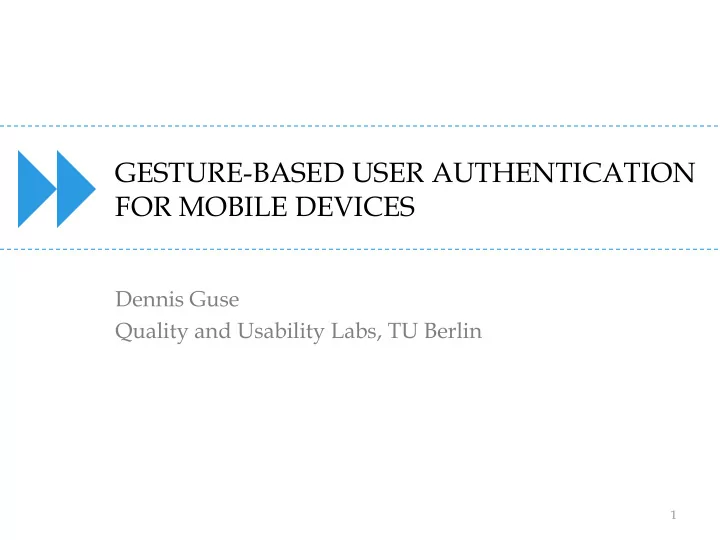

GESTURE-BASED USER AUTHENTICATION FOR MOBILE DEVICES Dennis Guse Quality and Usability Labs, TU Berlin 1
AUTHENTICATION ON MOBILE DEVICES Mobile Devices Interaction style Limitations 2
GESTURE-BASED USER AUTHENTICATION Personalized gesture + Natural input + Memorization 3
DEMO Demo 4
IMPLEMENTATION Motion Sensors Length Constraint 3D-Accelerometer 3D-Gyroscope Algorithms Hidden Markov Models Manual segmentation Dynamic-Time-Warping Push-to-gesture-button & 5
EVALUATION 1. Feasibility Proof-of-Concept-Study 2. Usability 3. Potential Attacks Forgery-Study Tools Gesture Recorder Questionnaires Designed Gestures 6
TOOLS: DESIGNED GESTURE Description: Move the device starting in direction of the arrow in parallel to your upper torso. Start and finish the gesture at the position of the play- and stop-symbol. 7
USER STUDIES Proof-of-Concept-Study Forgery-Study 15 Participants 10 Participants 5 Enrollment 12 attacked interpretations 15 for validation 100 forgeries per interpretation 8
RESULTS (I) User Acceptance + 12/ 15 easily memorable + 15/ 15 not exhausting + 13/ 15 would use it in public – 7/15 easily forgeable – Less secure than passwords 9
RESULTS (II) Forger Perception – Gestures perceived as not complicated – Easily learnable – Easily forgeable 10
RESULTS (III) DTW HMM 30 30 25 25 FAR in % FAR in % 20 20 15 15 10 10 5 5 0 0 15 20 25 30 35 40 15 20 25 30 35 40 FRR in % FRR in % Naïve Semi-naïve Visual Naïve Semi-naïve Visual 11
THANK YOU FOR YOUR ATTENTION { } Future Work Study usability in daily life • Study feasibility in daily life • Study user acceptance • Study user perception • Study resistance • Refine algorithms • 12
BIBLIOGRAPHY [1] Abdulla, Waleed H.; Chow, D.; Sin, G. Cross-words Reference Template for DTW-based Speech Recognition Systems , TENCON 2003, 1576-1579. [2] Chong, M. K.; Marsden, G . Exploring the Use of Discrete Gestures for Authentication . Proc. INTERACT 2009, Springer, 205-213. [3] Farella, E.; O’Modhrain, S.; Benini, L.; Riccó, B. Gesture Signature for Ambient Intelligence: A Feasibility Study . LNCS Vol. 3968, Springer, 2006, 288-304. [4] Guerra Casanova, J.; Sánchez Ávila, C.; de Santos Sierra, A.; Bailador del Pozo, G.; Jara Vera , V. A Real-Time In-Air Signature Biometric Technique Using a Mobile Device Embedding an Accelerometer. CCIS Vol. 87, Springer, 2010. [5 ] Guse, D. Gesture-based User Authentication for Mobile Devices (Master Thesis) , TU Berlin, 2011. [6] Matsuo, K.; Okumura, F.; Hashimoto, M.; Sakazawa, S.; Hatori, Y. Arm Swing Identification Method with Template Update for Long Term Stability . LNCS Vol. 4642, Springer, 2007, 211-221. [7] Okumura, F.; Kubota, A.; Hatori, Y.; Matsuo, K.; Hashimoto, M.; Koike, A. A Study on Biometric Authentication based on Arm Sweep Action with Acceleration . Proc. ISPACS 2006, IEEE, 219-222. [8] Rabiner, L. R.; Juang, B. H. An Introduction to Hidden Markov Models , ASSP Magazine, Vol. 3, IEEE, 1986, 4-16. [9 ] Sakoe, H.; Chiba, S. Dynamic Programming Algorithm Optimization for Spoken Word Recognition . IEEE Transactions on Acoustics, Speech and Signal Processing, Vol. 26, 1978, 43-49. 13
Recommend
More recommend